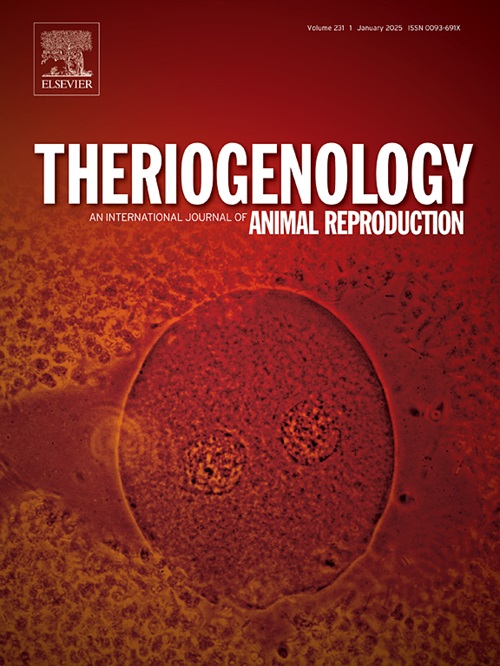南美牛肉生产的未来。
IF 2.4
2区 农林科学
Q3 REPRODUCTIVE BIOLOGY
引用次数: 0
摘要
南美的牛肉生产因气候、环境条件、动物品种(牛、金牛和杂交牛)、管理策略和营养来源的不同而各异。在南美牛肉生产系统中应用技术可以显著提高效率、可持续性和盈利能力。繁殖效率是一项重大挑战,尤其是在不利条件下进行的母牛-小牛饲养系统。因此,实施有效的辅助繁殖技术(ART)可做出重大贡献。在过去的二十年里,固定时间人工授精(FTAI)方案的发展使得人工授精在南美肉牛饲养管理和遗传改良中得到了广泛应用。如今,固定时间人工授精已在南美大规模应用,每年约有 20% 的小母牛和母牛接受这项技术。这使得该地区的产犊率提高,遗传增益显著。此外,主要使用性别选择精子的体外胚胎生产也在该地区得到了广泛应用,从而显著提高了牛群的遗传性和生产率。最近,在南美洲的所有胚胎移植中,有 94% 是体外生产的胚胎(41429 个是体内产生的胚胎,650782 个是体外生产的胚胎),主要采用固定时间胚胎移植技术(FTET)。基因组选择与使用小母牛卵母细胞进行体外胚胎生产相结合,提供了一个强大的技术平台,可缩短世代间隔,显著提高肉牛的遗传增殖率。新兴的生物技术,如通过 CRISPR/Cas 系统进行基因组编辑,正在得到开发,以提高生产率,增强对不利环境条件的适应能力,提高抗病力,并控制影响牲畜的害虫种类。最后,尽管所有这些技术都具有巨大的潜力,但要改变畜牧业生产,还需要取得进一步的进展。南美洲地域辽阔,气候多样,因此区域知识对于使牛肉生产符合可持续发展目标和支持全球粮食安全至关重要。本文章由计算机程序翻译,如有差异,请以英文原文为准。
The future of beef production in South America
South American beef production varies due to diverse climates, environmental conditions, animal breeds (Bos indicus, Bos taurus and crossbreeds), management strategies, and nutritional sources. Applying technology in the South American beef production system can significantly enhance efficiency, sustainability, and profitability. Reproductive efficiency is a significant challenge, especially in cow-calf operation systems conducted under adverse conditions. Consequently, implementing effective assisted reproduction technologies (ART) can make a significant contribution. In the last two decades, the development of fixed-time artificial insemination (FTAI) protocols permitted the widespread application of artificial insemination for breeding management and genetic improvement in beef herds in South America. Nowadays, FTAI is being applied in South America in large-scale programs, with around 20 % of heifers and cows receiving this technology every year. This results in a greater calving rate and significant genetic gain occurring in this territory. Also, in vitro embryo production, mainly using sex-selected sperm has been widely applied in this region, leading to significant improvements in herd genetics and productivity. Recently, 94 % of all embryo transfers in South America consist of in vitro-produced embryos (41,429 being in vivo-derived and 650,782 being in vitro-produced embryos), mainly using fixed-time embryo transfer technology (FTET). Genomic selection combined with in vitro embryo production with oocytes from heifer calves provides a powerful technology platform to reduce generation interval and significantly increase the rate of genetic gain in beef cattle. Emerging biotechnologies, such as genome editing via the CRISPR/Cas system, are being developed to enhance productivity, confer resilience to adverse environmental conditions, increase disease resistance, and control pest species that affect livestock. Finally, while all these technologies offer significant potential, further progresses are needed to transform livestock production. The vast geographical scale and diverse climates of South America make regional knowledge crucial for aligning beef production with sustainability goals and supporting global food security.
求助全文
通过发布文献求助,成功后即可免费获取论文全文。
去求助
来源期刊

Theriogenology
农林科学-生殖生物学
CiteScore
5.50
自引率
14.30%
发文量
387
审稿时长
72 days
期刊介绍:
Theriogenology provides an international forum for researchers, clinicians, and industry professionals in animal reproductive biology. This acclaimed journal publishes articles on a wide range of topics in reproductive and developmental biology, of domestic mammal, avian, and aquatic species as well as wild species which are the object of veterinary care in research or conservation programs.
 求助内容:
求助内容: 应助结果提醒方式:
应助结果提醒方式:


